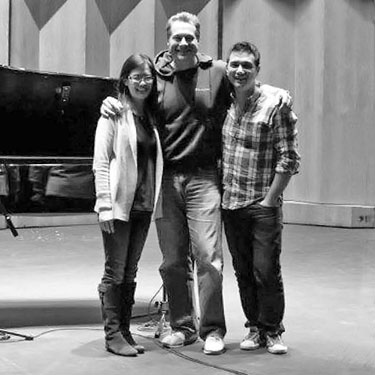|
 From left, Myra Huang, Marlan Barry and Nicholas Phan during the recording of Still Falls The Rain.Nicholas Phan is one of the most exciting new voices in classical music today, as evidenced by the tremendous praise heaped on him from just about every media outlet in the country. He frequently records with New York-based sound engineer Marlan Barry, and the two worked together on 2011's critically-acclaimed Winter Words. From left, Myra Huang, Marlan Barry and Nicholas Phan during the recording of Still Falls The Rain.Nicholas Phan is one of the most exciting new voices in classical music today, as evidenced by the tremendous praise heaped on him from just about every media outlet in the country. He frequently records with New York-based sound engineer Marlan Barry, and the two worked together on 2011's critically-acclaimed Winter Words.
The New York Times flagged it as one of the best classical recordings of 2011. The duo joined forces to record 2012's Still Falls the Rain, which yet again made The Times' "best of" list. Of course, the talent and artistry of Phan and his fellow musicians, together with the sonic vision of Barry, deserve the credit for those critical acknowledgements, but it's interesting to note the distinction between the gear used to record those two albums. For Winter Words, Barry piloted the console at a multi-million dollar recording studio, whereas for Still Falls the Rain, he piloted a MacBook Pro interfaced with a single-rack-space Metric Halo ULN-8. Neither session was a compromise.
In celebration of the centennial of his birth, Still Falls The Rain is an album of songs and chamber pieces by composer Benjamin Britten. Philadelphia Orchestra principal horn player Jennifer Montone, pianist Myra Huang, and Harpist Sivan Magen joined the amazing young tenor, and the actor Alan Cumming complemented the music with a reading of Edith Sitwell's poetry. Avie Records released the recording, which took place within the exquisite and often-recorded acoustics of SUNY Purchase's Recital Hall C.
In contrast both to the earlier studio recording and to Barry's previous habit of lugging a studio's worth of equipment to location sessions, the engineer traveled light for the two-day engagement in Recital Hall C. A MacBook Pro coupled to a pair of Avastor external hard drive served as the recording medium, and Barry's Genelec monitors provided a familiar reference. Apart from a simple custom talkback system, the only other equipment consisted of microphones, stands, cables, and the Metric Halo ULN-8. "It was very minimal," laughed Barry. "I'm into minimal these days."
Four Sennheiser and Schoeps omni-directional microphones provided primary pickup of the musicians and their interaction with the acoustical environment. Depending on the composition and the instrumentation, Barry moved the microphones around to strike a perfect balance between direct pickup and imaging. A pair of Neumann mics covered the room's nine-foot concert grand Hamburg Steinway D piano. For one of the more essential components of the recording session, Barry also used two Gunter Wagner U-47 tube microphones to capture Phan's incomparable voice, as well as a stereo pair on the harpist.
"This was the first time I used Wagner's U-47 without an external preamp," Barry explained. "I went directly out of the power supply into the Metric Halo ULN-8. I wanted to capture the detailed sound of that mic and its unique tube saturation, without imposing any other circuitry's coloration on it. Nick's voice is so light and airy and beautiful – that mic and his voice form a magical combination. Sure, the ULN-8 has circuitry of its own, but I've found that unless I'm intentionally using Metric Halo's 'Character' algorithms, the ULN-8's signal path is refined, short, and transparent."
Barry cites the Metric Halo ULN-8's stable integration with his MacBook Pro via Metric Halo's MIO Console software as a critical component in fostering confidence in the stability of his sessions. Despite using the Metric Halo on a near daily-basis, he has never had so much as a tiny hiccup in its performance. "Conducting a recording session with the rock-solid ULN-8 not only gives me peace of mind, it affects the musicians as well," he said. "A reliable, high-quality recording setup inspires confidence. It is an amazing testament to Metric Halo that I have never had a single issue with my ULN-8 or its performance on my laptop or desktop."
When not in session, Barry uses a Metric Halo ULN-8 as the primary interface at his studio. While useful for voiceovers or overdubbing, it more commonly acts as the digital-to-analog converter that allows him to monitor his editing, mixing, and mastering work in Pyramix, Pro Tools, or Logic. "That's really the last check before a recording goes public," he said. "Truthfulness is paramount, and I've learned that I can trust what I'm hearing through the ULN-8." |